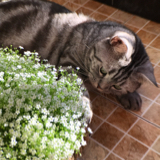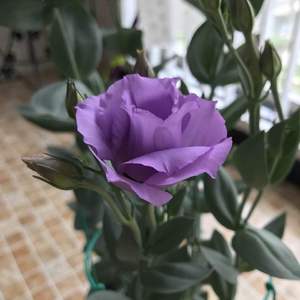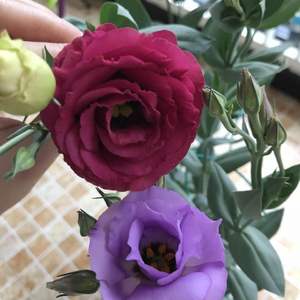文章
Miss Chen
2018年06月16日

Description: This is a herbaceous vine about 2-6' long that is either unbranched or branched occasionally. It either sprawls across the ground or climbs adjacent vegetation. This vine is either a summer annual or perennial (there are differing descriptions in this regard). The stems are light green, glabrous, angular, and prickly along their angles. The prickles are retrorse (curve downward) and about 1 mm. in length. Alternate leaves occur at intervals along the stems. These leaves are 2½-6" long and 2-4" across; they are hastate to broadly hastate in shape and smooth along their margins. The basal lobes of these leaves are triangular-shaped and divergent. Leaf tips taper to an acute point, while leaf bases are indented. The upper leaf surfaces are medium green and glabrous to sparsely short-pubescent, while the lower leaf surfaces are light green and sparsely to moderately covered with short stellate hairs. Small retrorse prickles occur along the major veins on the leaf undersides. Petioles are ½-4" long (becoming shorter as they approach the terminal points of stems), light green, and plano-convex (flat or slightly concave along their upper sides, convex along their lower sides). There are also retrorse prickles along the lower sides of the petioles. At the bases of petioles, there are ochrea (membranous sheaths) up to ½" long that wrap around the stems. These ochrea have rings of retrorse prickles around their bases, and their upper margins are often ciliate.
Both axillary and terminal inflorescences are produced on peduncles about 1-4" long. These inflorescences are variable, consisting of dense head-like racemes, interrupted racemes that are sparsely flowered, and/or sparsely branched panicles consisting of 2 or more racemes. Sometimes only a single flower is produced, rather than a raceme of flowers. Each flower is about ¼" (5-6 mm.) long, consisting of 4-5 tepals, an ovary with a pair of styles, and 6 stamens (less often 8 stamens). The tepals can be reddish white, pinkish white, greenish white, or white; they are broadly elliptic in shape. The peduncles are light green, glandular-hairy, and sometimes prickly below. The blooming period occurs from mid-summer into the fall, lasting about 1-3 months. Afterwards, the flowers are replaced by seeds that are 3.5-4.0 mm. long and a little less across at maturity; they are ovoid, slightly flattened, biconvex (rounded on both sides), dark brown, and shiny. This vine can spread vegetatively by forming rootlets when the nodes of stems touch moist ground.
Cultivation: This vine prefers partial sun, wet to consistently moist conditions, and soil containing some sand and decaying organic matter (silt and other soil types may also be acceptable). Most growth and development occurs during the summer.

Range & Habitat: Halberd-Leaved Tearthumb is native to only a few counties in the eastern half of Illinois (see Distribution Map). It is state-listed as 'endangered.' This vine is probably extirpated from Macon and McHenry counties because their specimens were collected prior to 1875 (Mohlenbrock, 2002). Illinois lies along the western-range limit of this species; it is more common further to the east. Habitats include bottomland woodlands, swamps, seeps and springs, low areas along ponds, and sloughs with fairly consistent moisture levels. Many of the preceding habitats, where this vine occurs, are often sandy and partly shady. Halberd-Leaved Tearthumb is usually found in high quality natural areas.
Faunal Associations: Little is known about the floral-faunal relationships of this vine specifically, although they are probably similar to those of smartweeds (Persicaria spp.). The flowers are probably pollinated by small bees, various flies, small butterflies, and wasps. Insects that feed on various parts of smartweeds include the caterpillars of butterflies and moths, flea beetles, aphids, and stink bugs. In particular, caterpillars of the butterflies Lycaena helloides (Purplish Copper) and Lycaena hyllus (Bronze Copper) feed on the foliage of smartweeds. Such wetland birds as the Mallard and other dabbling ducks, some rails, and granivorous songbirds (e.g., Bobolink, Swamp Sparrow, Redwing Blackbird) eat the seeds. Because Halberd-Leaved Tearthumb can form a tangle of leaves and prickly stems, it is able to provide some protective cover to various kinds of wetland wildlife.

Photographic Location: An open sandy swamp at the Indiana Dunes State Park in NW Indiana.
Comments: Halberd-Leaved Tearthumb can be distinguished from other similar vines in Illinois by its prickly stems and hastate leaves (shaped like Medieval halberds). Its closest relative in the state, the more common Tracaulon sagittatum (Arrow-Leaved Tearthumb), differs by having sagittate leaves (shaped like arrowheads), ochrea that lack rings of prickles, and seeds that are bluntly 3-angled (rather than biconvex and two-sided). Many contemporary authorities prefer to merge Tearthumb vines (Tracaulon spp.) with the smartweeds (Persicaria spp.). As a result, they refer to Halberd-Leaved Tearthumb as Persicaria arifolia. Another scientific name for this species, Polygonum arifolium, also appears in older sources of information. The classification that is used here follows Mohlenbrock (2002) and Mohlenbrock (2010). The leaves of Halberd-Leaved Tearthumb superficially resemble the leaves of other species, both wild and cultivated, in the Arum family (Araceae). This similarity of form is the source of the scientific name for this species (arifolium).
Both axillary and terminal inflorescences are produced on peduncles about 1-4" long. These inflorescences are variable, consisting of dense head-like racemes, interrupted racemes that are sparsely flowered, and/or sparsely branched panicles consisting of 2 or more racemes. Sometimes only a single flower is produced, rather than a raceme of flowers. Each flower is about ¼" (5-6 mm.) long, consisting of 4-5 tepals, an ovary with a pair of styles, and 6 stamens (less often 8 stamens). The tepals can be reddish white, pinkish white, greenish white, or white; they are broadly elliptic in shape. The peduncles are light green, glandular-hairy, and sometimes prickly below. The blooming period occurs from mid-summer into the fall, lasting about 1-3 months. Afterwards, the flowers are replaced by seeds that are 3.5-4.0 mm. long and a little less across at maturity; they are ovoid, slightly flattened, biconvex (rounded on both sides), dark brown, and shiny. This vine can spread vegetatively by forming rootlets when the nodes of stems touch moist ground.
Cultivation: This vine prefers partial sun, wet to consistently moist conditions, and soil containing some sand and decaying organic matter (silt and other soil types may also be acceptable). Most growth and development occurs during the summer.

Range & Habitat: Halberd-Leaved Tearthumb is native to only a few counties in the eastern half of Illinois (see Distribution Map). It is state-listed as 'endangered.' This vine is probably extirpated from Macon and McHenry counties because their specimens were collected prior to 1875 (Mohlenbrock, 2002). Illinois lies along the western-range limit of this species; it is more common further to the east. Habitats include bottomland woodlands, swamps, seeps and springs, low areas along ponds, and sloughs with fairly consistent moisture levels. Many of the preceding habitats, where this vine occurs, are often sandy and partly shady. Halberd-Leaved Tearthumb is usually found in high quality natural areas.
Faunal Associations: Little is known about the floral-faunal relationships of this vine specifically, although they are probably similar to those of smartweeds (Persicaria spp.). The flowers are probably pollinated by small bees, various flies, small butterflies, and wasps. Insects that feed on various parts of smartweeds include the caterpillars of butterflies and moths, flea beetles, aphids, and stink bugs. In particular, caterpillars of the butterflies Lycaena helloides (Purplish Copper) and Lycaena hyllus (Bronze Copper) feed on the foliage of smartweeds. Such wetland birds as the Mallard and other dabbling ducks, some rails, and granivorous songbirds (e.g., Bobolink, Swamp Sparrow, Redwing Blackbird) eat the seeds. Because Halberd-Leaved Tearthumb can form a tangle of leaves and prickly stems, it is able to provide some protective cover to various kinds of wetland wildlife.

Photographic Location: An open sandy swamp at the Indiana Dunes State Park in NW Indiana.
Comments: Halberd-Leaved Tearthumb can be distinguished from other similar vines in Illinois by its prickly stems and hastate leaves (shaped like Medieval halberds). Its closest relative in the state, the more common Tracaulon sagittatum (Arrow-Leaved Tearthumb), differs by having sagittate leaves (shaped like arrowheads), ochrea that lack rings of prickles, and seeds that are bluntly 3-angled (rather than biconvex and two-sided). Many contemporary authorities prefer to merge Tearthumb vines (Tracaulon spp.) with the smartweeds (Persicaria spp.). As a result, they refer to Halberd-Leaved Tearthumb as Persicaria arifolia. Another scientific name for this species, Polygonum arifolium, also appears in older sources of information. The classification that is used here follows Mohlenbrock (2002) and Mohlenbrock (2010). The leaves of Halberd-Leaved Tearthumb superficially resemble the leaves of other species, both wild and cultivated, in the Arum family (Araceae). This similarity of form is the source of the scientific name for this species (arifolium).
0
0
文章
Miss Chen
2018年06月16日

Description: This herbaceous plant is an annual vine about 3-6' long that branches occasionally. It often climbs over adjacent vegetation (or itself), creating a tangle of stems and leaves. The stems are light green, yellowish green, or red; they are strongly angular and prickly. The well-developed prickles are curved with their tips pointing downward. Alternate leaves are widely spaced along the stems. The leaf blades are up to 4" long and 1" across; they are narrowly sagittate to sagittate in shape and their margins are smooth and slightly ciliate with stiff hairs. The upper blade surfaces are medium green and hairless, while their lower surfaces are pale green and slightly prickly along their central veins.
The leaves are sessile or they have petioles up to 1" long. Near the base of each petiole, there is an oblique membranous sheath (ochrea) that wraps around the stem; this sheath is largely devoid of hairs and prickles. Both terminal and axillary flowers are produced on short spike-like racemes. The racemes are globoid or ovoid-globoid in shape and up to ½" long; they are produced individually or in pairs on long naked peduncles up to 6" long. The flowers are densely arranged along each raceme. Individual flowers are about 1/8" (3 mm.) long, consisting of 5 white to pink tepals, 8 short stamens, and an ovary with a tripartite style. At the base of each raceme, there is a pair of small green bracts. Similarly, at the base of each flower,Distribution Map there is a pair of tiny bracts that are greenish yellow and ovate. The blooming period occurs from mid-summer into the fall and lasts about 2-3 months. Each flower is replaced by a single dark seed that is about 3 mm. long, ovoid, and bluntly 3-angled. This herbaceous vine can form rootlets where the stems are decumbent on moist open ground.
Cultivation: The preference is partial sun, wet to moist conditions, and soil containing silty loam, sand, gravel, or peat moss. Most growth and development occurs during the summer. Temporary flooding is tolerated.
Range & Habitat: Arrow-Leaved Tearthumb is occasional throughout Illinois, where it is native. In addition to its distribution in eastern North America, this herbaceous vine also occurs in China. It is found in a variety of wetland habitats, including marshes, swamps, recently burned bogs, gravelly seeps, low areas along springs, and soggy thickets. The marshes, swamps, and soggy thickets where this vine occurs are sometimes sandy and sometimes non-sandy.
Faunal Associations: The floral-faunal relationships of Arrow-Leaved Tearthumb are similar to Persicaria spp. (Smartweeds). The nectar and pollen of the flowers attract primarily small bees, wasps, and flies. The leaves are eaten by the caterpillars of the butterflies Lycaena helloides (Purplish Copper) and Lycaena hyllus (Bronze Copper), while the flowers and developing seeds are eaten by the caterpillars of the butterfly Strymon melinus (Gray Hairstreak). Other insects that feed on this plant include flea beetles, aphids, stinkbugs, and the caterpillars of several moths. Various species of birds that occur in wetlands eat the seeds; these include Mallards and other dappling ducks, some rails, and granivorous songbirds (e.g., Bobolink, Swamp Sparrow, Redwing Blackbird). Because it often forms dense tangles of prickly stems and leaves, Tearthumb provides protective cover for various kinds of wildlife.
Photographic Location: A soggy sandy thicket at the Iroquois County Conservation Area in Illinois.

Comments: Arrow-Leaved Tearthumb is very similar to the more common Persicaria spp. (Smartweeds), except it is a sprawling vine rather than an erect plant. Because of its prickly stems, arrowhead-shaped leaves, and short dense heads of flowers, it is very easy to identify. Another native species that is a sprawling vine, Tracaulon arifolium (Hastate-Leaved Tearthumb), is very similar in appearance, except its leaves are hastate with spreading basal lobes. This uncommon vine also differs from Arrow-Leaved Tearthumb by its more flattened seeds and bifurcated styles (divided into two parts, rather than three). A scientific synonym of Arrow-Leaved Tearthumb is Polygonum sagittatum.
The leaves are sessile or they have petioles up to 1" long. Near the base of each petiole, there is an oblique membranous sheath (ochrea) that wraps around the stem; this sheath is largely devoid of hairs and prickles. Both terminal and axillary flowers are produced on short spike-like racemes. The racemes are globoid or ovoid-globoid in shape and up to ½" long; they are produced individually or in pairs on long naked peduncles up to 6" long. The flowers are densely arranged along each raceme. Individual flowers are about 1/8" (3 mm.) long, consisting of 5 white to pink tepals, 8 short stamens, and an ovary with a tripartite style. At the base of each raceme, there is a pair of small green bracts. Similarly, at the base of each flower,Distribution Map there is a pair of tiny bracts that are greenish yellow and ovate. The blooming period occurs from mid-summer into the fall and lasts about 2-3 months. Each flower is replaced by a single dark seed that is about 3 mm. long, ovoid, and bluntly 3-angled. This herbaceous vine can form rootlets where the stems are decumbent on moist open ground.
Cultivation: The preference is partial sun, wet to moist conditions, and soil containing silty loam, sand, gravel, or peat moss. Most growth and development occurs during the summer. Temporary flooding is tolerated.
Range & Habitat: Arrow-Leaved Tearthumb is occasional throughout Illinois, where it is native. In addition to its distribution in eastern North America, this herbaceous vine also occurs in China. It is found in a variety of wetland habitats, including marshes, swamps, recently burned bogs, gravelly seeps, low areas along springs, and soggy thickets. The marshes, swamps, and soggy thickets where this vine occurs are sometimes sandy and sometimes non-sandy.
Faunal Associations: The floral-faunal relationships of Arrow-Leaved Tearthumb are similar to Persicaria spp. (Smartweeds). The nectar and pollen of the flowers attract primarily small bees, wasps, and flies. The leaves are eaten by the caterpillars of the butterflies Lycaena helloides (Purplish Copper) and Lycaena hyllus (Bronze Copper), while the flowers and developing seeds are eaten by the caterpillars of the butterfly Strymon melinus (Gray Hairstreak). Other insects that feed on this plant include flea beetles, aphids, stinkbugs, and the caterpillars of several moths. Various species of birds that occur in wetlands eat the seeds; these include Mallards and other dappling ducks, some rails, and granivorous songbirds (e.g., Bobolink, Swamp Sparrow, Redwing Blackbird). Because it often forms dense tangles of prickly stems and leaves, Tearthumb provides protective cover for various kinds of wildlife.
Photographic Location: A soggy sandy thicket at the Iroquois County Conservation Area in Illinois.

Comments: Arrow-Leaved Tearthumb is very similar to the more common Persicaria spp. (Smartweeds), except it is a sprawling vine rather than an erect plant. Because of its prickly stems, arrowhead-shaped leaves, and short dense heads of flowers, it is very easy to identify. Another native species that is a sprawling vine, Tracaulon arifolium (Hastate-Leaved Tearthumb), is very similar in appearance, except its leaves are hastate with spreading basal lobes. This uncommon vine also differs from Arrow-Leaved Tearthumb by its more flattened seeds and bifurcated styles (divided into two parts, rather than three). A scientific synonym of Arrow-Leaved Tearthumb is Polygonum sagittatum.
0
0
文章
Miss Chen
2018年06月15日

Description: This perennial plant is 3-6' tall, branching sparingly. The stems are terete and glabrous. The alternate leaves are up to 6" long and 4" across (excluding the petioles); they are usually divided into 3-5 pointed lobes and their margins are serrate-crenate. Leaves with 3 lobes resemble a medieval halberd because the middle lobe is much longer than the 2 lateral lobes. Leaves with 5 lobes have the shape of a maple leaf. Some of the leaves may be unlobed; they are lanceolate to ovate in shape. The leaves are glabrous and their venation is partially palmate. The petioles are long and slender. The upper stems terminate in either a solitary or small cluster of flowers.
Each flower is up to 5" across when fully open, consisting of 5 rounded petals, a columnar reproductive structure, and a green calyx with 5 oval lobes. The petals are pink to nearly white. The reproductive column consists of whorled stamens and a divided style at its tip. The throat of the flower is reddish purple. Around the base of the calyx, there are several linear bracts. The blooming period occurs from mid- to late summer, lasting about 1 month. Each flower lasts only a single day. The rather large seeds are finely hairy and irregularly shaped – they tend to be flat-sided and reniform, but this is not always the case. Their fine hairs are white or brown. The seeds are light for their size, and probably distributed by movement of water. The root system consists of a taproot. This plant spreads by reseeding itself.

Cultivation: The preference is full or partial sun, fertile soil, and wet conditions. Flowers require exposure to sunlight to open up properly. This wetland species doesn't like to dry out.
Range & Habitat: The native Halberd-Leaved Rose Mallow has been observed in most areas of Illinois, except for extreme northern Illinois and some south central areas of the state (see Distribution Map). Habitats include marshes, swamps, low areas along rivers and ponds, and soggy islands in the middle of rivers or ponds. It is not often found in highly disturbed areas, and doesn't compete well against the invasive Salix interior (Sandbar Willow).

Faunal Associations: The nectar and pollen of the flowers attract bumblebees and an oligolectic bee, Ptilothrix bombiformis. Another common floral visitor, Melitoma taurea, is oligolectic on Ipomoea spp. (Morning Glory), but it is attracted to the large funnelform flowers of other plants. Some insects feed destructively on Hibiscus spp. (Rose Mallow). Caterpillars of the butterfly, Strymon melinus (Gray Hairstreak), feed on the flower buds and developing seeds, while caterpillars of the butterfly, Vanessa cardui (Painted Lady), feed on the foliage, as do caterpillars of Pyrgus communis (Checkered Skipper). Larvae of such moths as Eudryas unio (Pearly Wood Nymph), Anomis erosa (Yellow Scallop Moth), Automeris io (Io Moth), and Acontia delecta (Delightful Bird-Dropping Moth) also feed on these plants; the latter moth is found south of Illinois, however.

Other insect feeders include the flea beetle Chaetocnema quadricollis, larvae of the sawfly Atomacera decepta, the jewel beetle Paragrilus tenuis, adults of Popillia japonica (Japanese Beetle), and some aphid species. Deer and livestock will eat the non-toxic foliage of native Hibiscus spp. readily. However, the introduced shrub, Hibiscus syriacus (Rose-of-Sharon), which is often planted in yards, is apparently more resistant to browsing by deer than the native Hibiscus spp.
Photographic Location: Along a large drainage ditch at the Windsor Road Prairie in Champaign, Illinois, where this species was introduced.

Comments: Halberd-Leaved Rose Mallow has large beautiful flowers that can be seen from a distance. Other native Hibiscus spp. in Illinois include Hibiscus moscheutos (Swamp Rose Mallow) and Hibiscus lasiocarpus (Hairy Rose Mallow). Halberd-Leaved Rose Mallow can be distinguished by its lobed leaves, as the latter two species have unlobed leaves that are oval-ovate in shape. While Halberd-Leaved Rose Mallow has hairless leaves and hairy seeds, Swamp Rose Mallow and Hairy Rose Mallow have hairy leaf undersides and hairless seeds! All of these species have similar flowers and they prefer similar wetland habitats, although Hairy Rose Mallow has a more southern distribution within the state. A scientific synonym of the Halberd-Leaved Rose Mallow is Hibiscus militaris.
Each flower is up to 5" across when fully open, consisting of 5 rounded petals, a columnar reproductive structure, and a green calyx with 5 oval lobes. The petals are pink to nearly white. The reproductive column consists of whorled stamens and a divided style at its tip. The throat of the flower is reddish purple. Around the base of the calyx, there are several linear bracts. The blooming period occurs from mid- to late summer, lasting about 1 month. Each flower lasts only a single day. The rather large seeds are finely hairy and irregularly shaped – they tend to be flat-sided and reniform, but this is not always the case. Their fine hairs are white or brown. The seeds are light for their size, and probably distributed by movement of water. The root system consists of a taproot. This plant spreads by reseeding itself.

Cultivation: The preference is full or partial sun, fertile soil, and wet conditions. Flowers require exposure to sunlight to open up properly. This wetland species doesn't like to dry out.
Range & Habitat: The native Halberd-Leaved Rose Mallow has been observed in most areas of Illinois, except for extreme northern Illinois and some south central areas of the state (see Distribution Map). Habitats include marshes, swamps, low areas along rivers and ponds, and soggy islands in the middle of rivers or ponds. It is not often found in highly disturbed areas, and doesn't compete well against the invasive Salix interior (Sandbar Willow).

Faunal Associations: The nectar and pollen of the flowers attract bumblebees and an oligolectic bee, Ptilothrix bombiformis. Another common floral visitor, Melitoma taurea, is oligolectic on Ipomoea spp. (Morning Glory), but it is attracted to the large funnelform flowers of other plants. Some insects feed destructively on Hibiscus spp. (Rose Mallow). Caterpillars of the butterfly, Strymon melinus (Gray Hairstreak), feed on the flower buds and developing seeds, while caterpillars of the butterfly, Vanessa cardui (Painted Lady), feed on the foliage, as do caterpillars of Pyrgus communis (Checkered Skipper). Larvae of such moths as Eudryas unio (Pearly Wood Nymph), Anomis erosa (Yellow Scallop Moth), Automeris io (Io Moth), and Acontia delecta (Delightful Bird-Dropping Moth) also feed on these plants; the latter moth is found south of Illinois, however.

Other insect feeders include the flea beetle Chaetocnema quadricollis, larvae of the sawfly Atomacera decepta, the jewel beetle Paragrilus tenuis, adults of Popillia japonica (Japanese Beetle), and some aphid species. Deer and livestock will eat the non-toxic foliage of native Hibiscus spp. readily. However, the introduced shrub, Hibiscus syriacus (Rose-of-Sharon), which is often planted in yards, is apparently more resistant to browsing by deer than the native Hibiscus spp.
Photographic Location: Along a large drainage ditch at the Windsor Road Prairie in Champaign, Illinois, where this species was introduced.

Comments: Halberd-Leaved Rose Mallow has large beautiful flowers that can be seen from a distance. Other native Hibiscus spp. in Illinois include Hibiscus moscheutos (Swamp Rose Mallow) and Hibiscus lasiocarpus (Hairy Rose Mallow). Halberd-Leaved Rose Mallow can be distinguished by its lobed leaves, as the latter two species have unlobed leaves that are oval-ovate in shape. While Halberd-Leaved Rose Mallow has hairless leaves and hairy seeds, Swamp Rose Mallow and Hairy Rose Mallow have hairy leaf undersides and hairless seeds! All of these species have similar flowers and they prefer similar wetland habitats, although Hairy Rose Mallow has a more southern distribution within the state. A scientific synonym of the Halberd-Leaved Rose Mallow is Hibiscus militaris.
0
0

























